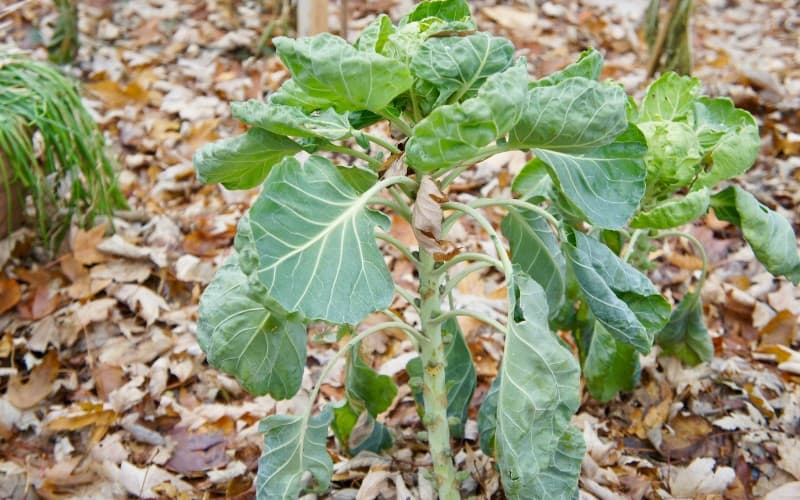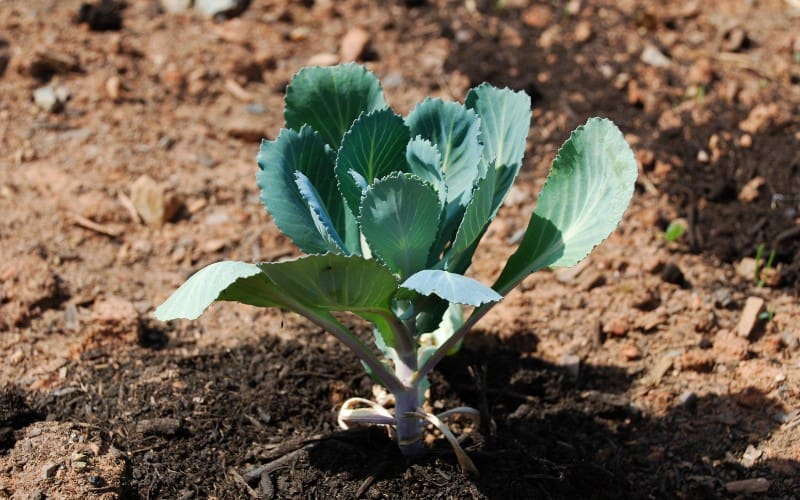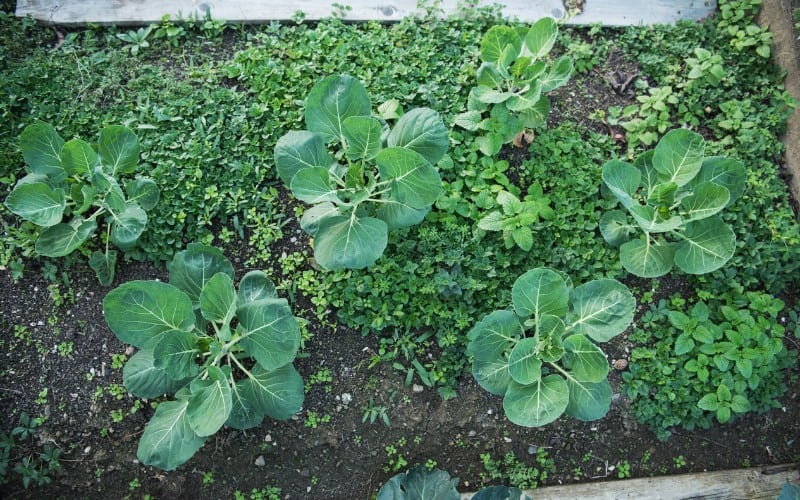Most commonly grown for its edible buds, the brussels sprouts belong to the Gemmifera Group of cabbages.
For many gardeners, growing a good crop of brussels sprouts can be a herculean task. It means figuring out answers to questions like what is the best time of the year to grow brussels sprouts? How big or how tall do brussels sprouts grow? And so on.
In terms of growth, fully matured, healthy brussels sprouts can grow about 2 ½ feet tall when properly taken care.
This plant has specific cultivating requirements, unlike most other vegetables. The good thing is that when these specifications are met, you can be sure your robust, tall brussels sprouts garden would reward you with at least two months' supply of this staple vegetable.
Read Also: How to Grow Brussel Sprouts
Table of Contents
How Tall Do Brussels Sprout Grow?
When adequately spaced and all other criteria for healthy growth are met, the brussels sprout plant will grow about 2 ½ feet tall when fully mature. To achieve this, you will want to provide 24 to 36 inches of space between plants when growing in rows, and 24 inches in any direction when planting in a bed.
Keep in mind that transplanting stunted brussels sprout seedlings may lead to plants that never fully mature. Getting healthy seeds and ensuring that you meet the necessities at different brussels sprouts growing stages is key to having your plant reach its natural height.
Brussels sprouts grow in the leaf axil or joint and then begin maturing upward from the bottom of the plant.
They grow tall first and don't start producing sprouts until they reach almost full height (about 3 months post-transplant).
You can start harvesting between 70-90 days after transplanting when the plant is approximately 2 ½ feet tall. The lower sprouts, the size of large marbles, i.e., when the individual sprouts reach 1 to 2 inches in diameter. 100 to 110 days after sowing seed (70-90 post-transplant) depending on the variety, you know your Brussels sprouts are mature.
It is essential that you pick the sprouts before they get too large or become pale yellow and turning bitter or start cracking and become unsuitable for eating.
And as long as it is firm and compact, bright green with no signs of yellowing, how tall your brussels sprouts grow is immaterial.
The University of Illinois Extension opines that you begin harvesting when the sprouts are firm and from the bottom of the stalk, where the sprouts should be most extensive.
Brussels Sprouts Growing Stages
Sowing
Often grown for a late fall harvest, brussels sprouts are slow-growing, cool temperature plants that can stand up to frost.
Work towards spacing your sprouts about 2 feet apart with 3 feet between rows. Enclose the seeds with ¼- to ½-inch of soil and keep moist.
Transplant when the seedlings are about 3 inches tall (about 5 weeks after sowing). It is essential that you don't allow the seedlings to become root-bound, or the brussels sprouts plants will fail to grow tall when transplanted.
The brussels sprouts growth happens 80 to 100 days from transplant to harvest and generally does best in temperatures from 45 to 75 degrees Fahrenheit (7.2 to 23.8°C).
Conditions for Optimum Growth
For optimum growth, plant 1 seed per module between ½ inch (1.25 cm) to 2cm deep in an 84cell modular plant tray.
They will germinate in 7-12 days and be ready to transplant to the garden about 4-6 weeks later.
It is essential to keep your seedlings adequately watered before you plant them out in the garden. The bedding should be moist but not soggy from over-watering.
Please do your best not underwater, too, as this can lead to the compost plug completely dry out or form a crust on top, leaving it unable to absorb the moisture the next time you water.
The amount of water required will depend on the weather. This is why you might consider watering twice a day on very sunny days and once on 2 days in mild climates. Hydration is a vital determining factor of how tall your brussels sprout will grow ultimately.
In mild-winter regions, grow the brussels sprouts in late summer or autumn for winter or cool spring harvest. In most areas, it is best to plant brussels sprouts so that they can be ready for harvest in autumn.
To achieve this, you need to start seeds indoors/in a suitable nursery 12 to 14 weeks before the first frost in autumn.
The bottom line is to time your planting so that the brussels sprouts do not grow in periods of extended warm weather much above 70°.
Brussels sprouts thrive in loose organic soil that retains moisture. Brussels sprouts like a pH level of 6.0 to 6.5, and they do best in full sun but will tolerate partial shade.
Transplanting
Brussels sprouts plants are large and so require a seemingly large planting space. The tall varieties of this plant need 90cm between plants and 90cm between rows; smaller types require a spacing of 70cm between plants and 70cm between rows.
When you are ready for the transplant, approximately five weeks later, make a hole in the soil with a dibber or trowel slightly more profound than the seedling root ball.
The next step is to plant the seedling up to the first real leaves' level, i.e., the second set of leaves produced after the initial rounded seed leaves, and push the soil in around the plant with your fingers. The aim is to attain a firm connection between the root ball and surrounding soil.
How to Care for Brussels Sprouts
Water the plants at the base after transplanting and do well to keep well-watered throughout the growing season to prevent the ground from drying out.
It is essential to water the crop adequately during the growing season as the plants require water for optimal growth and sprout development.
Brussels sprouts need a large amount of water but, at the same time, do not like standing water. As expected, lighter soils require to be watered more frequently than thicker soils.
Also, removing the plant's growing tip about 4 weeks to the harvesting date will result in greater yields as the plant will divert attention from leaf growth into developing the Brussels sprout and achieving tall brussels sprouts.
Feed brussels sprouts with organic compost or a nitrogen fertilizer every few weeks. Stop fertilizing when you cut back on the water supply at the end of the growing season.
In addition to feeding the plants, it will and provide a sound barrier for weeds. Doing this will ensure that the question: how tall do brussels sprouts grow? wouldn't be a concern of yours. As long as you do all that is recommended at the respective brussels sprouts growing stages.
Brussels Sprouts Weed Control and Eradication

Timely weed control at different growth stages is required to stimulate the brussels plant's growth to reach maximum potential.
Weed about the plant carefully by hand. Only use a weeding instrument when necessary. Brussels sprouts have a very shallow root system and do not appreciate their surrounding soil being over-disturbed.
An excellent weed control tool to use for the brussels sprouts is the oscillating stirrup hoe. Albeit old fashioned, it is a handy tool and the ultimate brussels sprouts gardener's best friend.
This gardening tool removes the weeds and breaks up the surface of the soil to create a good tilth. A tilth permits air and moisture into the roots of your plants, thus increasing their vigor and significantly contributing to how tall your brussels sprouts will grow.
Pests/Diseases Control
Asides from environmental limitations, pests, and diseases are the other factors that can oppose how tall your brussels sprout will eventually grow.
That said, brussels sprouts are prone to the same problems as cabbage and broccoli.
The most common pests include cabbage looper, cabbage worm, aphids, cabbage root maggot, and Harlequin bug.
Being that this crop requires several months to germinate and grow, you should make time to monitor for problems periodically, especially right before the sprouts start forming.
Diseases prone to this plant include downy mildew, black rot, and clubroot. To mitigate a disease like clubroot (a soil-borne fungus), what you need to do is introduce calcium and magnesium to the soil and raise the soil pH to about 6.5.
On the whole, disease control is best obtained by rotating the crop each year, according to Harvest to Table blog.
Conclusion
Timing is of great importance when growing this plant. Properly cultivating the brussels sprouts has to happen in the temperate time of the year. And although a slow-growing vegetable, the brussels sprouts is a very bountiful and nutritious crop worth every investment.
For you, a prospective brussels sprout gardener, most likely with questions like how tall do Brussels sprouts grow? What piece of information would come in handy at the various brussels sprouts growing stages? This article examined all that and more.
Plants that make a great companion for brussels sprouts include beets, celery, herbs, onions, potatoes, etc. Do your best to avoid pole beans, strawberries, tomatoes, and the likes, if you want your brussels sprouts to grow tall.






